The Dell Venue 8 7000 Series Review
by Brandon Chester on March 12, 2015 8:00 AM EST- Posted in
- Tablets
- Dell
- Android
- Mobile
- Venue 8 7000
CPU Performance
The Venue 8 is a unique device among the Android devices that we have tested. While most Android smartphones and tablets employ ARM based SoCs, Dell has opted to use Intel's Atom Z3580 processor. Z3580 is part of Intel's Moorefield line, built on Intel's 22nm process and sporting four Silvermont cores with a max burst frequency of 2.33GHz. To test CPU performance we turn to our standard web based benchmarks, along with Basemark OS II. For our 2015 benchmark suite we've removed Sunspider as it's become too much of an optimization target.

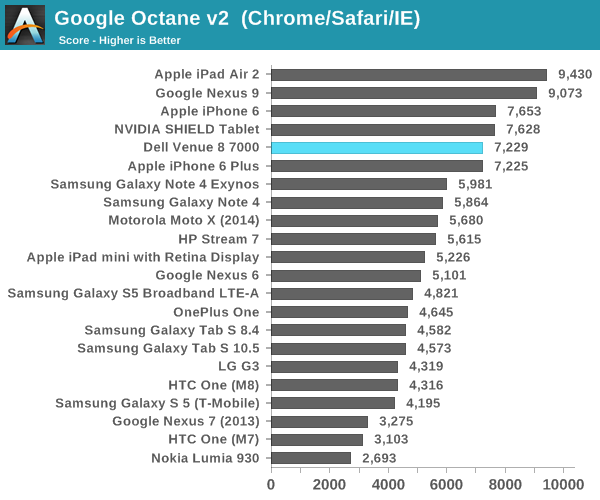
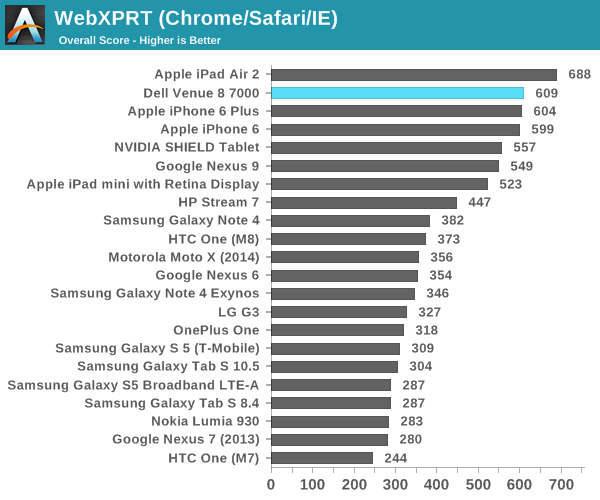
The Z3580 performs very well in all of our web based benchmarks. Its scores are in the same range as devices with Apple's A8 and NVIDIA's Tegra K1 which currently hold the best scores of the devices we've tested.
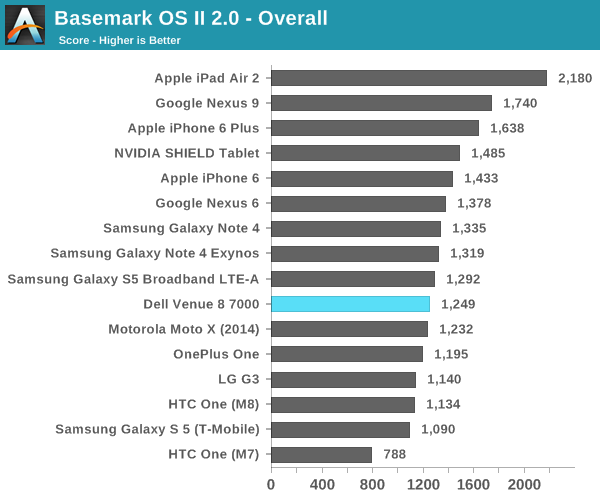


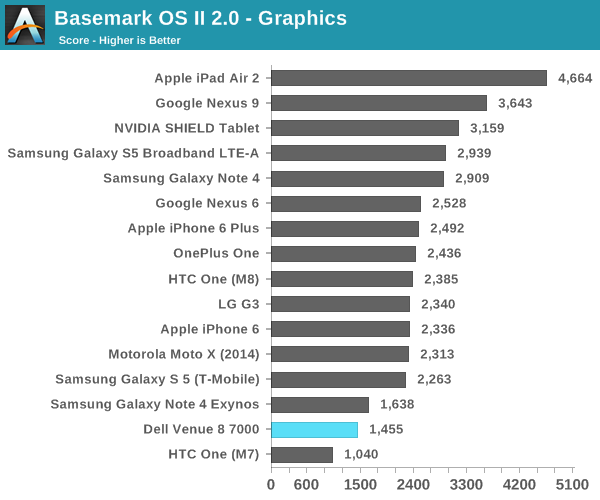
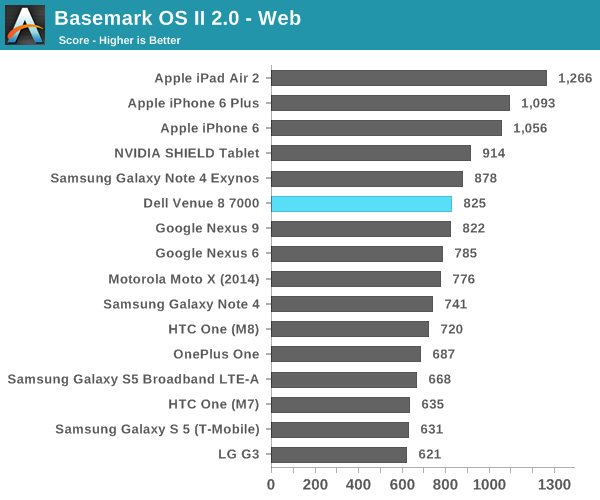
The performance in Basemark OS II is a mixed bag when compared to the consistently good results from our web benchmarks. We see fairly good performance in the web and memory sections of the benchmark, but less impressive scores in the system and graphics categories. This leads to an overall score that sits in the middle of the results from other devices we've tested.
Whether a tablet's performance is acceptable or not will often be based largely on how much the tablet costs. Class leading performance can't really be expected from inexpensive tablets, and for expensive ones having class leading performance is a must. At $399, the Venue 8 is priced at the same point as the Nexus 9, and it trades blows with it across our different tests. With generational improvements to their processors, it's not hard to imagine Intel becoming a major performance leader in the mobile space. Performance isn't the only metric considered when a manufacturer is deciding on the processor for their device, but I wouldn't be surprised if we end up seeing more design wins for Intel in the future.
Device Performance
A device's performance in benchmarks is a fairly objective measurement of performance, but it may not necessarily be representative of how a device actually feels to a user. Issues with performance in the real world can fall under many categories, which range from long loading times to stutters and sluggish framerates. The "jank" that has historically existed on Android devices has typically fallen under the latter category rather than the former. With each iteration of Android, Google has made improvements to this perceived smoothness in the Android interface. The recently released Android Lollipop brought large increases to framerates in many key areas, but the Venue 8 ships with KitKat and can not take advantage of them.
Unfortunately, the Android 4.4 KitKat experience on the Venue 8 is not always as free from jank as one would expect based on its CPU performance. Many issues manifest themselves as stutters or drops in framerate, even in common animations like bring down the notification shade and rotating the device. Turning on any live wallpapers is also guaranteed to bring the animations in the launcher well below 60fps, and even below 30fps. Many scrolling lists also suffer from the jank that was commonly seen on pre-Lollipop versions of Android. It's unfortunate that the Venue 8 didn't ship with Lollipop, as I don't think I would have to discuss performance issues like these if it had. Hopefully a Lollipop update arrives for the Venue 8 soon.


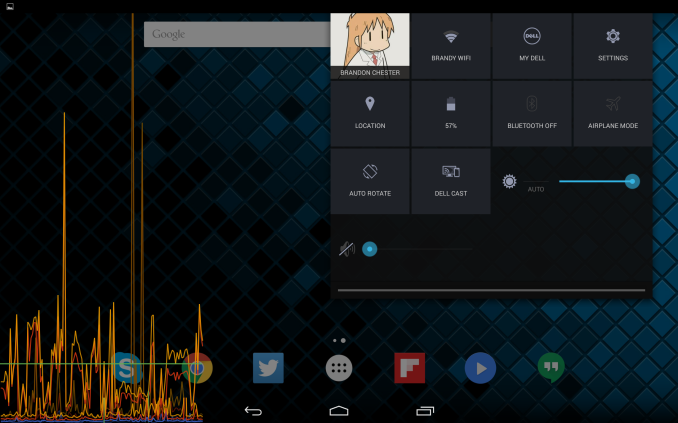








89 Comments
View All Comments
darkich - Thursday, March 12, 2015 - link
your Intel *bias*Michael Bay - Thursday, March 12, 2015 - link
Consider how faster Atom became when Baytrail came. That`s generational improvement the article is talking about.Intel also always will be on superior process node compared to everyone else.
It`s only a question of supplying better GPU part.
lucam - Thursday, March 12, 2015 - link
This GPU is good, but not enough maybe for a tablet.darkich - Friday, March 13, 2015 - link
Lol.Consider how faster Cortex became from A9-A72. Around 400%.
Astonishing achievement that Intel can only have pipe dreams about.
LukaP - Friday, March 13, 2015 - link
Considering Intel managed to get Broadwell into 4.5W space i wouldnt be too worried about them. Their next gen atoms will be on par with any arm design. Dont forget that they have atleast one node advantage (with 10nm that will be two nodes) and ALOT more money to pour into RND.Look at what they are doing with iGPU performance. they realised AMD was stealing their market there, and came up with the Gen8 Iris Pro.
Same will happen in mobile. when intel wants something it takes it. Plus it helps that they can rely on the Intel Inside branding.
pSupaNova - Friday, March 13, 2015 - link
Every generation we hear the same arguments spouted by the Intel Crowd, then when the mobile products hit the market ARM based Socs beat Intels hands down.Intel can't own this market big players like Samsung & Apple who manufacture devices and design ARM SOCS will not let them gain a big enough foothold in the market.
The Mobile SOC race is over ARM won and Intel are now scrambling for the scraps.
Michael Bay - Friday, March 13, 2015 - link
Samsung SoCs are the ones scrambling for the scraps even within Samsung lineup, and Apple will always will be a thing in itself.This battle is far from over, and rushing to proclaim someone a winner only uncovers one`s uncertainty.
darkich - Friday, March 13, 2015 - link
That 4.5W Broadwell costs over $250, and is matched(in raw computing performance) by a $50 2W Exynos 7420, and almost matched by last year's 20nm A8X..Seriously, there is no competition whatsoever. Facts are overwhelmingly in favor of ARM based chips.
darkich - Friday, March 13, 2015 - link
Also, so far Intel always had a node advantage but trailed behind ARM despite of that.Now even that advantage is melting away.
Samsung is actually the first to have tested a 10nm process
Michael Bay - Friday, March 13, 2015 - link
Intel process advantage "melting away"?Nice mantra.
It took them literally years and years to get where intel was two years ago process-wise, and then it`s not even real 14nm. You`ll get years after years of Samsung milking it completely dry, then TSMC yields will finally catch up and they`ll have to think about moving to 10.
Intel will be somewhere below 5 by then.